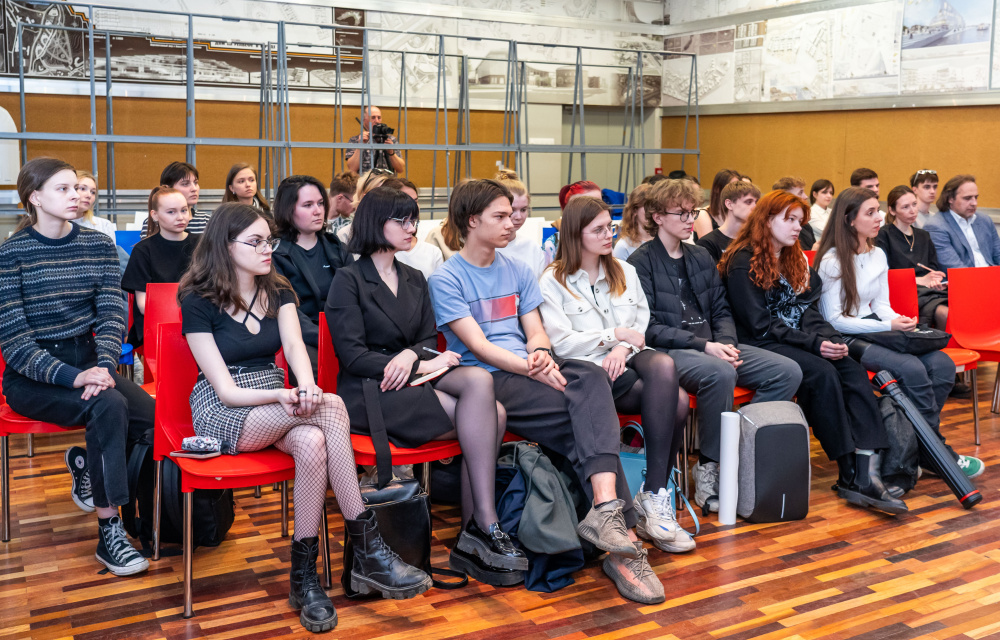 The discussion was attended by the students of the Faculty of Architecture
The discussion was attended by the students of the Faculty of Architecture
Within the framework of the IV International Conference-Forum "SPbGASU Architectural Seasons" on 24 April, a public discussion was held between representatives of the academic community, the tourism industry, practicing experts in the field of architecture and students, during which the issues of sustainable development of infrastructure for nature tourism were discussed.
 Vera Burtseva, Dmitry Kolosov, Sergey Lutchenko, Illarion Komarov and Daria Boytsova
Vera Burtseva, Dmitry Kolosov, Sergey Lutchenko, Illarion Komarov and Daria Boytsova
The discussion was attended by Sergey Lutchenko, First Deputy Chairman of the Committee for Urban Planning Policy - Chief Architect of the Leningrad Region, Dmitry Kolosov, Director for Sustainable Development of the Rosa Khutor Resort, Vera Burtseva, Director of the Research Institute for Sustainable Development in Construction (ANO NIIURS), Chief Architect of the Architectural Bureau "MAParchitects" Illarion Komarov, Dean of the SPbGASU Faculty of Architecture Ekaterina Voznyik, Deputy Dean for Career Guidance Counceling Oleg Fedorov, Senior Lecturer at the Department of Architectural Design Daria Boytsova.
 Ekaterina Vozniak, Oleg Fedorov and Vera Burtseva
Ekaterina Vozniak, Oleg Fedorov and Vera Burtseva
Opening the discussion, Ekaterina Vozniak noted the importance of the "Architectural Seasons": every year, discussions of the future of architecture are held in the open areas of the forum, rationalization proposals are made, and the most talented students are identified. “This discussion is an excellent opportunity for students to communicate with representatives of government and business. In a productive dialogue, the guys will learn a lot of useful things in the field of tourism infrastructure,” said Ekaterina Vozniak.
Dmitry Kolosov stressed that today in the field of tourism there is a clear interest in outdoor recreation. “However, each person has his own preferences in how to carry out recreational activities; we are united only in the desire to restore strength and peace of mind in the bosom of nature. The task of the architect is to organize an accessible, comfortable and safe space for recreation, taking into account the characteristics of the natural environment and being guided by a careful attitude to its preservation, so that it becomes a place of attraction for tourist flows,” he said.
Sergey Lutchenko added that when designing tourism infrastructure, it is necessary to take into account areas with special conditions for the use of the territory, the category of land, types of land use, as well as conduct a comprehensive urban planning analysis of the territory in order to determine the feasibility of building infrastructure facilities and prospects for the development of the territory. With all the nuances, the high natural and recreational potential serves as an incentive for the development of tourism infrastructure. “If five years ago Staraya Ladoga was visited annually by 150,000 tourists a year, then over the past year - half a million, Vyborg used to receive about half a million tourists, now it is 1.2 million a year. In such a sought-after area, we need modern proposals for the organization of spaces, the architectural and spatial solution of tourism and recreation facilities, and the arrangement of tourism infrastructure. I am sure that young architects can offer this,” the speaker said.
As Oleg Fedorov noted, the design of simple tourist facilities at the faculty has been taught since the first year, when students carry out projects that provide for minimal impact on the natural environment and take into account the philosophy of the area. Daria Boytsova drew attention to the interdisciplinary approach to design, which showed the greatest efficiency both in practical and educational activities.
“The design of any object, including a tourist one, begins with a serious pre-design analysis, during which urban planning restrictions, social needs, historical context, economic introductory and other aspects that affect the future object are identified. This is how the most promising scenarios for the activities of tourists are formed, which determine the basis of the functional and architectural model of the complex being designed. When working with students, we also pay attention to the aspect of energy efficiency of buildings - this topic is especially relevant when designing tourist facilities that are remote from centralized communications and located in a natural area,” explained Daria Boytsova.
“We are talking about a portrait of a future user, a forecast of tourist flows, the expediency of objects for business development,” agreed Illarion Komarov. According to him, the effectiveness of this approach is confirmed by practice: this is how the specialists of the MAParchitects architectural bureau developed a master plan for the Celestial Piccks Complex subcluster with an area of 6701 hectares in the Kemerovo region. The development of the infrastructure of the complex will increase the tourist flow, create 450 job places, and the investment will pay off in four to seven years.
“Modern architects face colossal tasks that need to be solved competently and promptly, and I am sure that you, today's students and tomorrow's young professionals, will cope with them,” Vera Burtseva addressed the students.
Many of the students present had previously submitted applications for the All-Russian competition of clauses "Tourist's green shelter in the natural area", organized by ANO "NIIURS". The competition is co-organized by SPbGASU and Rosa Khutor Resort. After the discussion, the guys received tasks and discussed with the experts the requirements for them, the details of their implementation.
“The competition allows students to get acquainted with modern approaches to sustainable development in construction, study the recommendations of the GREEN ZOOM standard for tourism industry facilities, as well as activities and solutions that allow creating more environmentally friendly, water and energy efficient facilities in natural areas. We will make every effort to find opportunities for the implementation of the guys' best projects,” concluded Vera Burtseva.